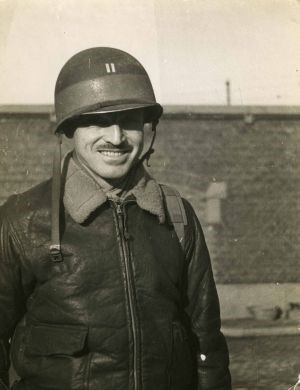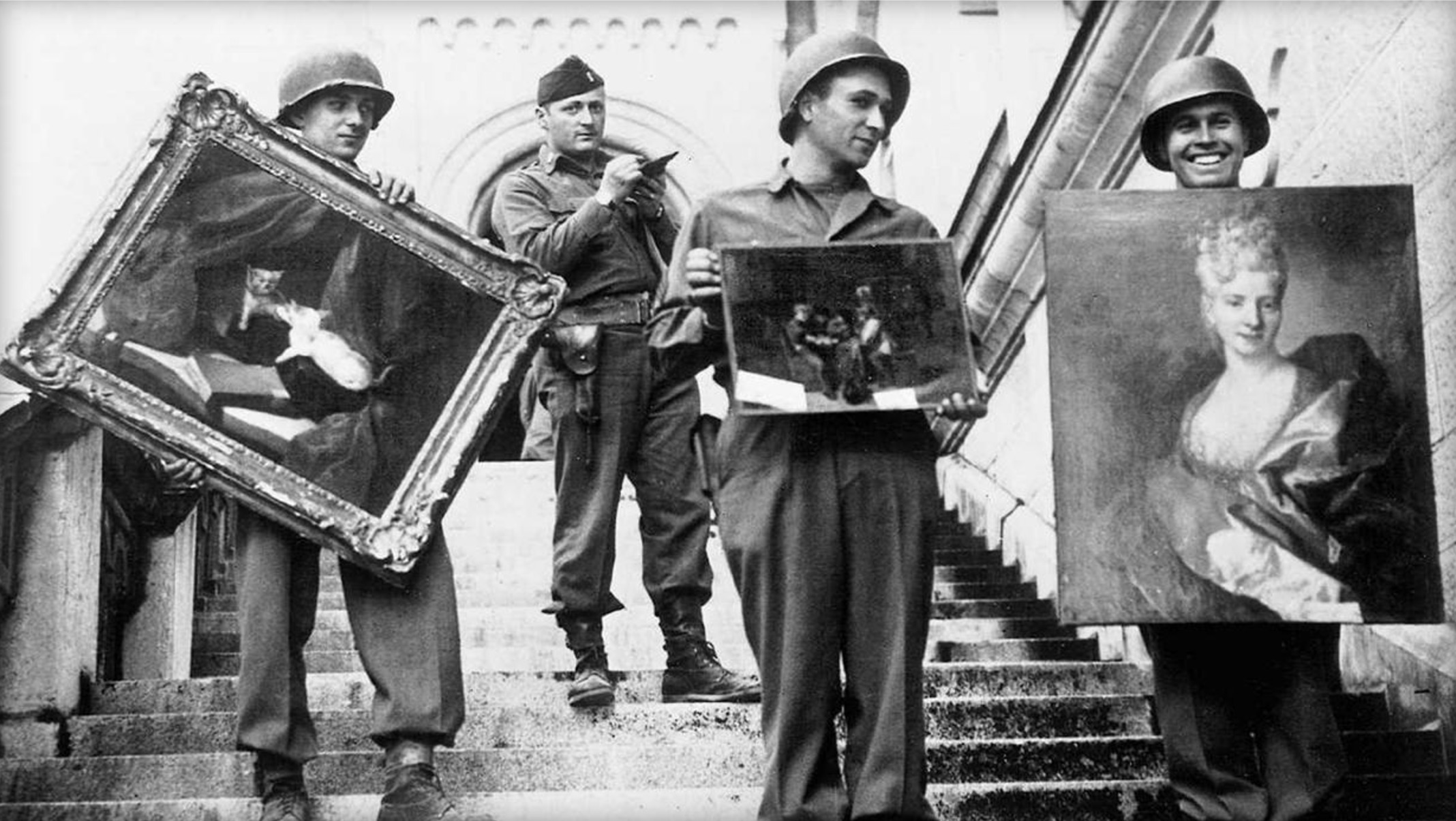The Monuments Men outside Neuschwanstein Castle, Germany, 1945. Photo: US Army.
“In the areas ravaged by bombings and gunfights, there are monuments that are dear to the people of those regions and cities: churches, sanctuaries, statues, paintings and all kinds of works of art. Some may have been destroyed, others damaged. They all run the risk of being further damaged, robbed or destroyed.” — Monument Officer George Stout
The Monuments, Fine Arts, and Archives program (MFAA) was a crucial initiative by the Allies that aimed to preserve the cultural heritage of Europe during and after World War II. The MFAA was composed of about 350 volunteers from 13 countries, mostly art historians, museum curators, and other experts, who became known as the “monuments men” and “monuments women”. They worked with the Allied armies to safeguard historic monuments, artworks, and archives from war damage and Nazi looting. They also tracked down and recovered millions of stolen or hidden cultural items and returned them to their rightful owners or institutions.
One of the pioneers of art conservation in the United States was a man named George Stout, who had a keen interest in protecting artistic and historical treasures since his youth. He authored a booklet in 1942 to urge the US government to intervene and safeguard the cultural heritage at risk. Stout was an inspiration for the MFAA and served as an officer in the program when it was established.

The Nazi looting of art during World War II was one of the most extensive and systematic cases of art theft in history. It originated with the policies of the Nazi regime, which systematically looted occupied territories of their cultural property for ideological and financial purposes. The Nazis targeted private Jewish collections, public museums, and organizations deemed to be at odds with Nazi ideology, such as Freemasons. They also confiscated art that they considered to be “degenerate”, meaning modernist, expressionist, or otherwise not conforming to their aesthetic standards.

The Nazis had a three-pronged strategy for plundering art: (1) drain Germany of its “degenerate” art; (2) confiscate Jewish-held art from private collections and Jewish institutions, including schools and synagogues, in conquered countries; and (3) levy outrageous taxes against fleeing Jewish families and confiscate their art collections as “payment”. The Nazis also planned to create a massive museum in Linz, Austria, called the Führermuseum, where they would display the most valuable and acclaimed works of European art that they had stolen or acquired. However, this museum was never realized, and many of the artworks that were intended for it are still missing today.
The Nazi looting was not only motivated by ideological and financial purposes, but also by personal greed and vanity. , such as Adolf Hitler, Hermann Göring, Joseph Goebbels, Alfred Rosenberg, Martin Bormann, and numerous others, amassed huge collections of artworks for their own enjoyment or for their planned museums and residences.

The MFAA was established in 1943 under the Civil Affairs and Military Government Sections of the Allied armies, following the efforts of various art professionals and organizations to lobby for a national body that would protect cultural property in war areas. The MFAA operated until 1946, when it was dissolved after completing its mission. The legacy of the MFAA is still celebrated today, as many of its members went on to have influential careers in the art world and some of their stories have been depicted in books and film..
Among the notable achievements of the MFAA were saving the Ghent Altarpiece, a masterpiece of Flemish art, from a salt mine in Austria where it had been hidden by the Nazis; recovering thousands of artworks from Neuschwanstein Castle in Germany, where Hermann Göring, one of the most powerful figures in the Nazi Party and one of the main architects of the Nazi police state, had amassed a huge collection of looted art; restoring the damaged frescoes of the Camposanto Monumentale in Pisa, Italy, after a fire caused by an Allied bombing; locating and returning the manuscripts of Beethoven, Mozart, and Goethe that had been stolen from libraries and archives across Europe; preventing the destruction of Leonardo da Vinci’s Last Supper in Milan, Italy, by installing protective scaffolding around the mural; and advising the military commanders on how to avoid bombing or shelling culturally significant sites, such as cathedrals, museums, and monuments.

Some of the prominent members of the MFAA were James Rorimer, who later became the director of the Metropolitan Museum of Art in New York; Rose Valland, who secretly recorded the movements of looted art from the Jeu de Paume museum in Paris and helped recover them after the war; George Stout, who pioneered the field of art conservation and founded the Conservation Center at Harvard University; Edith Standen, who became a curator of European textiles at The Met and an authority on tapestries; Robert Posey and Walker Hancock, who discovered the Altaussee salt mine where many artworks were hidden and rescued them with the help of Austrian miners; and John Bryan Ward-Perkins, who documented the damage to monuments in Italy and founded the British School at Rome.

The MFAA was portrayed in a 2014 war film, The Monuments Men, directed by George Clooney and written and produced by Clooney and Grant Heslov. The film starred an ensemble cast including Clooney, Matt Damon, Bill Murray, John Goodman, Jean Dujardin, Bob Balaban, Hugh Bonneville, and Cate Blanchett. The film was loosely based on the 2007 non-fiction book The Monuments Men: Allied Heroes, Nazi Thieves and the Greatest Treasure Hunt in History by Robert M. Edsel and Bret Witter. The film focused on an unlikely World War II platoon that was tasked to rescue art masterpieces from German thieves and return them to their owners.
The film took artistic liberties and failed to depict the historical facts of the MFAA accurately. As an example, the film compressed the timeline of events and made it seem like the MFAA was formed only after D-Day in 1944, when in fact it was established in 1943 and had been active in Italy before landing in Normandy. The film also changed the names and nationalities of some of the main characters, such as Frank Stokes (based on George Stout), James Granger (based on James Rorimer), Richard Campbell (based on Robert Posey), Walter Garfield (based on Walker Hancock), Jean Claude Clermont (based on Jacques Jaujard), Donald Jeffries (based on Ronald Balfour), Preston Savitz (based on Lincoln Kirstein), and Sam Epstein (based on Harry Ettlinger). Moreover, the film exaggerated some of the dangers and challenges faced by the MFAA, such as having to defuse a landmine under a barrel of gold or being shot at by a sniper while carrying a Madonna statue.

The film also omitted some of the important achievements and contributions of the MFAA, including saving Leonardo da Vinci’s Last Supper, recovering Beethoven’s manuscripts, restoring the Camposanto frescoes, or advising military commanders on avoiding cultural sites. The film also added some fictional elements that did not happen in reality, such as having a character die while trying to save Michelangelo’s Madonna of Bruges or having another character discover his brother’s death while looking at his dog tags.
Resource
Monuments Men and Women Foundation
MonumentsMenandWomenFnd.org
*The views and opinions expressed on this website are solely those of the original authors and contributors. These views and opinions do not necessarily represent those of Spotter Up Magazine, the administrative staff, and/or any/all contributors to this site.

